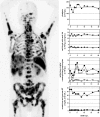²¹³Bi-DOTATOC receptor-targeted alpha-radionuclide therapy induces remission in neuroendocrine tumours refractory to beta radiation: a first-in-human experience
- PMID: 25070685
- PMCID: PMC4525192
- DOI: 10.1007/s00259-014-2857-9
²¹³Bi-DOTATOC receptor-targeted alpha-radionuclide therapy induces remission in neuroendocrine tumours refractory to beta radiation: a first-in-human experience
Abstract
Purpose: Radiopeptide therapy using a somatostatin analogue labelled with a beta emitter such as (90)Y/(177)Lu-DOTATOC is a new therapeutic option in neuroendocrine cancer. Alternative treatments for patients with refractory disease are rare. Here we report the first-in-human experience with (213)Bi-DOTATOC targeted alpha therapy (TAT) in patients pretreated with beta emitters.
Methods: Seven patients with progressive advanced neuroendocrine liver metastases refractory to treatment with (90)Y/(177)Lu-DOTATOC were treated with an intraarterial infusion of (213)Bi-DOTATOC, and one patient with bone marrow carcinosis was treated with a systemic infusion of (213)Bi-DOTATOC. Haematological, kidney and endocrine toxicities were assessed according to CTCAE criteria. Radiological response was assessed with contrast-enhanced MRI and (68)Ga-DOTATOC-PET/CT. More than 2 years of follow-up were available in seven patients.
Results: The biodistribution of (213)Bi-DOTATOC was evaluable with 440 keV gamma emission scans, and demonstrated specific tumour binding. Enduring responses were observed in all treated patients. Chronic kidney toxicity was moderate. Acute haematotoxicity was even less pronounced than with the preceding beta therapies.
Conclusion: TAT can induce remission of tumours refractory to beta radiation with favourable acute and mid-term toxicity at therapeutic effective doses.
Figures







References
-
- Kratochwil C, Giesel FL, López-Benítez R, Schimpfky N, Kunze K, Esenhut M, et al. Intraindividual comparison of selective arterial versus venous 68Ga-DOTATOC PET/CT in patients with gastroenteropancreatic neuroendocrine tumors. Clin Cancer Res. 2010;16(10):2899–2905. doi: 10.1158/1078-0432.CCR-10-0004. - DOI - PubMed
Publication types
MeSH terms
Substances
LinkOut - more resources
Full Text Sources
Other Literature Sources
Miscellaneous

